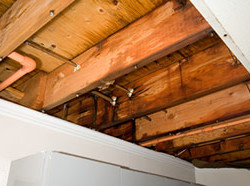Top Hazards for Your Home – Mold is Number One
The word “mold” is actually a generic catch-all term for a variety of fungi. Species of indoor mold include Aspergillus, Epicoccum and Trichoderma. No matter what the form, mold growth in your home or building can lead to a number of unpleasant and potentially serious effects.
The nature of mold
According to the definition used by the U.S. Environmental Protection Agency, mold and other fungi are plants, although they have no roots, leaves or flowers. Mold is most commonly thought of as being black or green, but it actually appears in yellow, pink and brown as well.
Mold reproduces by spores, which are microscopic cells that are invisible to the eye as they drift throughout the air. DIY mold treatment is usually ineffective because spores remain behind to land on other surfaces.
Moisture is the common denominator required for growth of any mold species. Water leaks are an obvious risk factor, but any damp surface in humid areas such as bathrooms and basements is a candidate for mold.
Mold’s destructive effects
Active mold growth destroys its host material. This is no problem outdoors, where mold breaks down organic matter as part of the cycle of nature. Indoors, unchecked mold growth can result in structural damage.
A more serious issue is mold’s potential impact on your health. The presence of mold has been associated with allergies and upper respiratory ailments, leading the Institute of Medicine to issue a report in 2004 citing damp indoor areas as a “public health problem.”
Our unique MoldExterm mold treatment program eliminates mold growth and provides a barrier against future infestations. Contact us today to schedule a free mold inspection.

